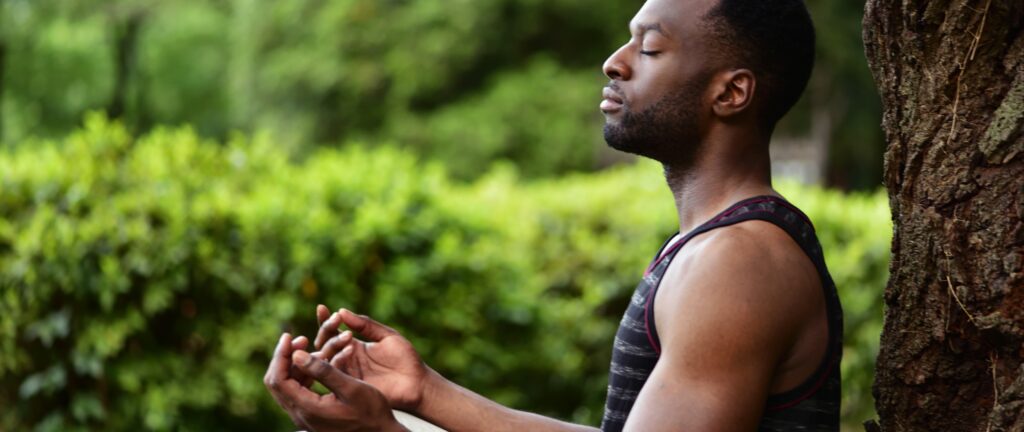Mindful May is in full swing here at Shepherd’s Dream, and we’ve already explored mindful eating and shared perspectives on a mindful Mother’s Day. Today we dig into the topic of mindfulness itself, as well as the ultimate life hacking tool—meditation. Which seems perfect in light of the facts that many cultures celebrate the original Buddha’s birthday in May and that this Sunday May 21 is World Meditation Day.
In a culture of high productivity and 24-7 living, it makes sense that mindfulness and meditation are also having their moment as an antidote. To harried Western minds, the Eastern practice of meditation can seem daunting, impractical, or near impossible. And yet, the evidence is clear that mindfulness techniques and meditation can vastly improve our lives by increasing focus and awareness, bringing clarity and peace, and providing us with a more centered and balanced outlook. If all the high-performing CEOs and thought leaders are doing it, maybe we should too?
And you don’t have to run away to a mountaintop monastery in Nepal or sit on a cushion for hours. You don’t even have to be “good” at it (whatever that means). Let’s take a peek at the more practical purposes and techniques that can make meditation a part of your life.

Let’s Contemplate Why
Meditation and mindfulness practices carry so many health benefits for all aspects of our being, that the question really becomes “Why aren’t we doing it already?!”
One of the biggest perks is stress management. Stress is a phenomenon that affects every system of our body and every area of our lives, from sleep to energy levels to mood to hunger signals. Everyone living a modern life is feeling stress these days, whether we’re aware of it or not. Bringing meditation into our daily lives can vastly help the various symptoms we may be experiencing, helping life feel smoother and more enjoyable.
Beyond stress, meditation and mindfulness practices also benefit us in numerous ways:
- Our Physical Body. How does better sleep and a more calm disposition sound? Stress can really do a number on our physical bodies, leading to headaches, high blood pressure, muscle tension, and insomnia. In addition, meditation has been shown to improve our immune system function for greater overall health and less susceptibility to illness. It also helps those who suffer from chronic pain, both by reducing pain perception and improving pain tolerance.
- For Mental Health. Meditation has been shown to help tremendously with our mental states. It can improve concentration and focus, reduce anxiety, increase clarity, and boost creativity.
- Emotional Regulation. By inviting mindfulness, we expand our capacity for more gratitude, peace, and acceptance. Through meditation, we can cultivate a kinder, more nonjudgmental attitude toward ourselves and others, thus improving our relationships and communication. All of this leads to greater inner strength and resiliency.

Now We Contemplate How
Meditation isn’t just sitting in a cave in a lotus position for years. There are no pre-qualifications or pre-requisites, no evaluations or contests—just the willingness to chill out for a few minutes with yourself.
And luckily, there are many different ways to do it. Some of us are more physical and kinetic, others might fare better listening to something, while others may appreciate complete peace and quiet. If one technique doesn’t work for you, don’t give up! There’s something out there for everyone. It takes some consistency and patience, but once the benefits begin making themselves felt in your daily life, you’re likely to be hooked.
- Mindfulness Meditation. This method involves paying nonjudgmental attention to the present moment, observing thoughts, sensations, and emotions as they arise, helping to cultivate awareness and a sense of presence.
- Loving-Kindness Meditation. Also known as metta meditation, this practice generates feelings of love, compassion, and goodwill toward oneself and others. It helps foster a sense of connection, understanding, and empathy.
- Transcendental Meditation™. Transcendental Meditation (aka TM) is a technique taught 1-on-1 that is reported to be easy to learn, easy to practice, and to be backed by research on its effectiveness. The use of sound helps quiet the mind and promote relaxation.
- Guided Visualization. This involves using mental imagery to create vivid and positive experiences. Guided visualization can be used for relaxation, healing, or manifesting specific goals by imagining them as already achieved. We have it on good word that this can be so effective, you can give birth while doing it.
- Body Scan Meditation. By systematically bringing attention to different parts of the body, noticing sensations, and cultivating body awareness, this method promotes relaxation, stress reduction, and a deeper connection with the physical self.
- Walking Meditation. Walking meditation, just as it sounds, brings mindfulness to the act of walking. It can be done indoors or outdoors, and it encourages focusing on the sensations of walking, the movement of the body, and the surrounding environment. Try this in a walking labyrinth if your community has one. Also check out the app by the community associated with the late teacher Thich Nhat Hanh—The Plum Village Mobile App is completely free and includes a guided walking meditation. Stack your walking meditation with some earthing practice by going barefoot, learn more about that here.
- Breath Awareness Meditation. This technique involves focusing on the breath as the primary object of attention. By observing the inhalation and exhalation, it helps anchor the mind in the present moment and cultivate calmness. Box Breath is a wonderfully simple way to experience this one, try a free exercise here.
- Mantra Meditation. Mantra meditation involves the repetition of a sacred word, phrase, or sound to help focus the mind and induce a meditative state. Kundalini yoga is one way to practice this alone or in community.
- Body Movement Meditation. This form of meditation combines gentle physical movement, such as yoga or tai chi, with mindful awareness. It promotes the integration of body and mind, fostering relaxation and a sense of flow.

Enlightening Pro Tips
- Create a dedicated space. If sitting or yoga is your thing, be sure to check out our products that support your practice! Our Meditation Pillow provides perfect cushioning for floor space. It doesn’t need to be an entire room, it might just be a corner of your bedroom or living room. Adorn it with other mindful decor, like an altar, statues, crystals, artwork, and inspirational books.
- Consider position and posture. Nobody has to do a full cross-legged lotus…or even half lotus. There’s a reason there are so many meditation props, cushions, and accessories—because it can be hard on the body to sit for so long! If cross-legged is too uncomfortable, try kneeling with a cushion or stool, sitting in a chair, or even lying down (as long as you don’t fall asleep!). Aligned posture will help prevent aches and pains from developing over time.
- Build community. Search for groups, classes, and workshops online or on local bulletin boards. Many spiritual and religious organizations hold meditation classes, as most lineages across all cultures have a tradition of meditation and contemplation in their history. Meditation is gaining in popularity, so if a secular approach is more your style, you’re likely to find resources for that too. Or try to get the whole house involved—kids, partners, housemates. Support and community will help you stay consistent.
- Guided meditation. In today’s hyperconnected technological world, resources abound! From apps to videos to online classes to podcasts, you can find whatever you need. Some to try: Calm (free on YouTube, also an app), Headspace (free on YouTube, also an app), Ten Percent Happier (especially good for the skeptics), and The Meditation Podcast.
- Go au naturel. Combine your nature time with meditation time—meditators have been seeking out the serenity of nature for eons. Some communities even have parks or temples with specific areas or gardens for contemplation.
As we begin exploring a meditation and mindfulness practice, we learn by seeking outside assistance and tools. We hope you’ve found some useful tips here! But eventually, as you reacquaint yourself with yourself over time, you might discover that, just like Dorothy in The Wizard of Oz, “You’ve always had the power my dear, you just had to learn it yourself.”
Follow along with us for more Mindful May on Instagram and Pinterest, and as always, sweet dreams!

